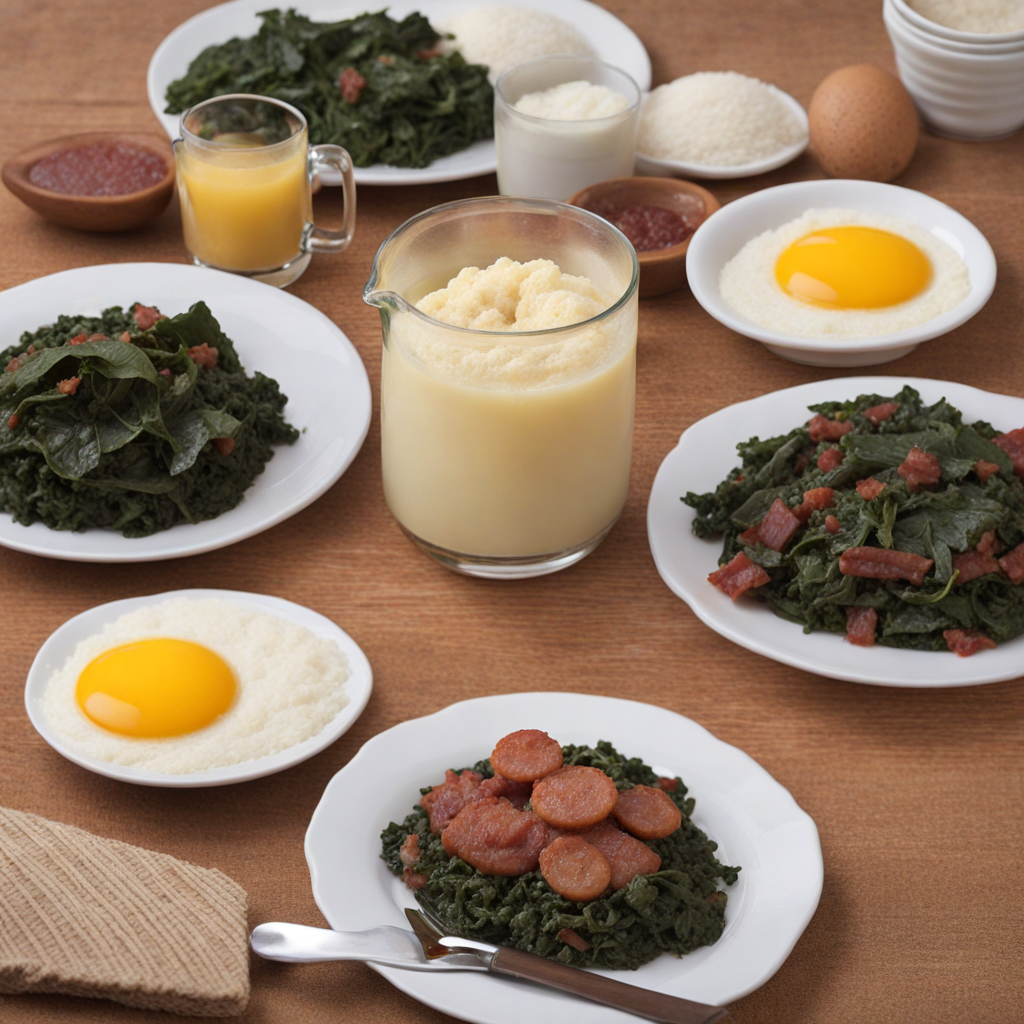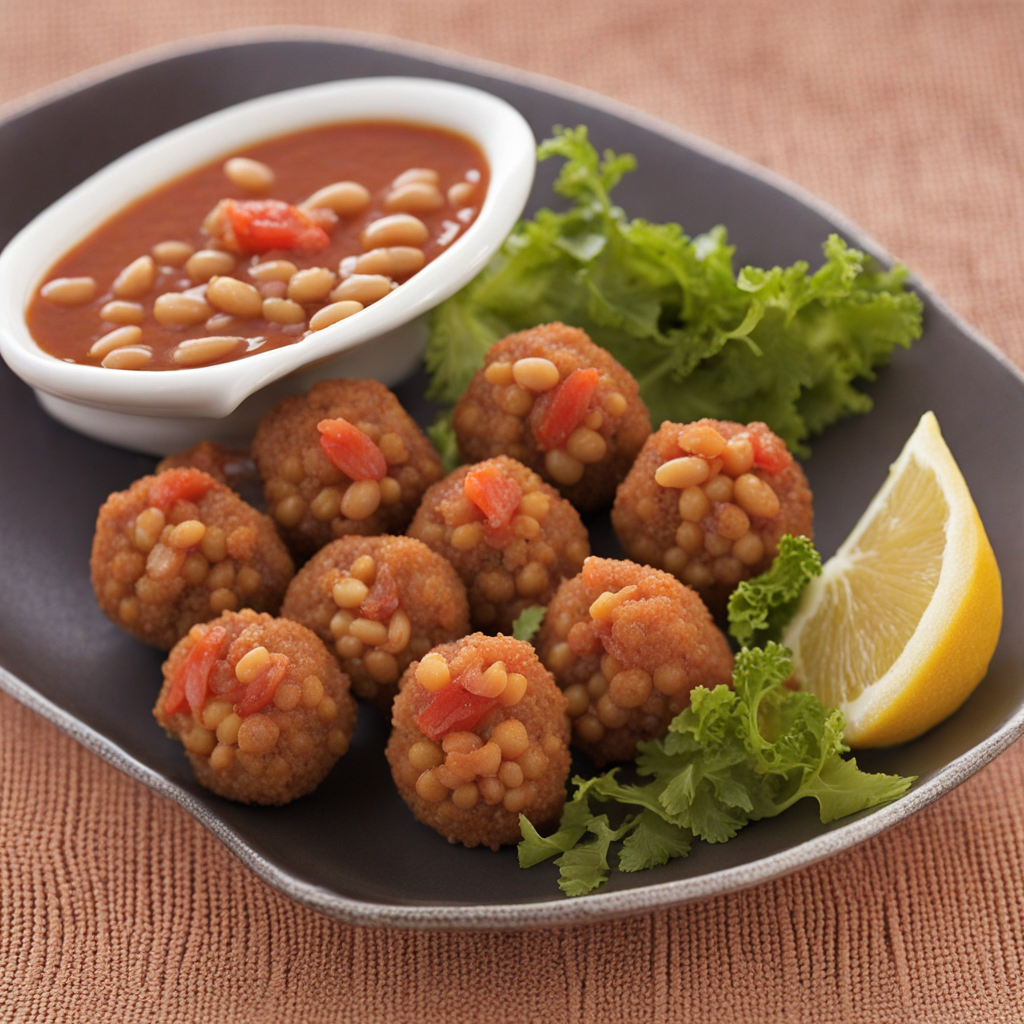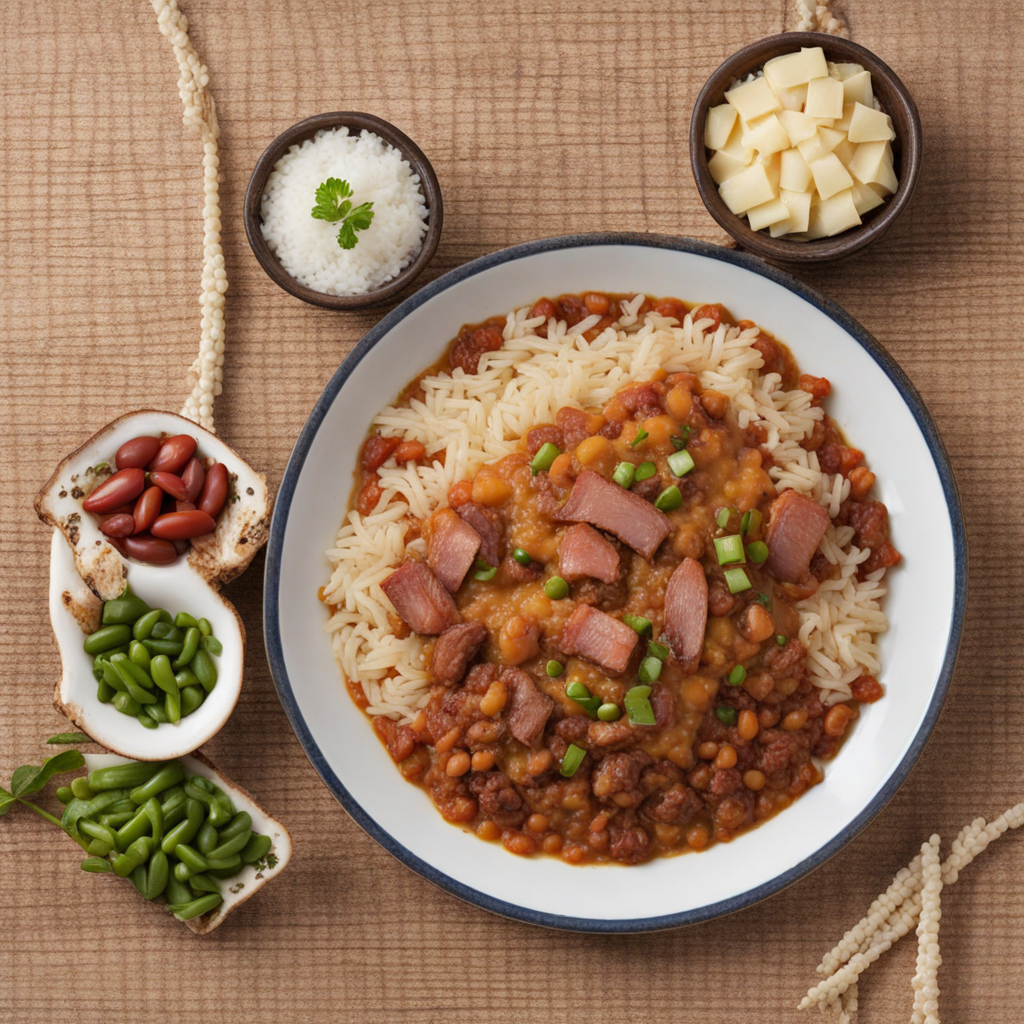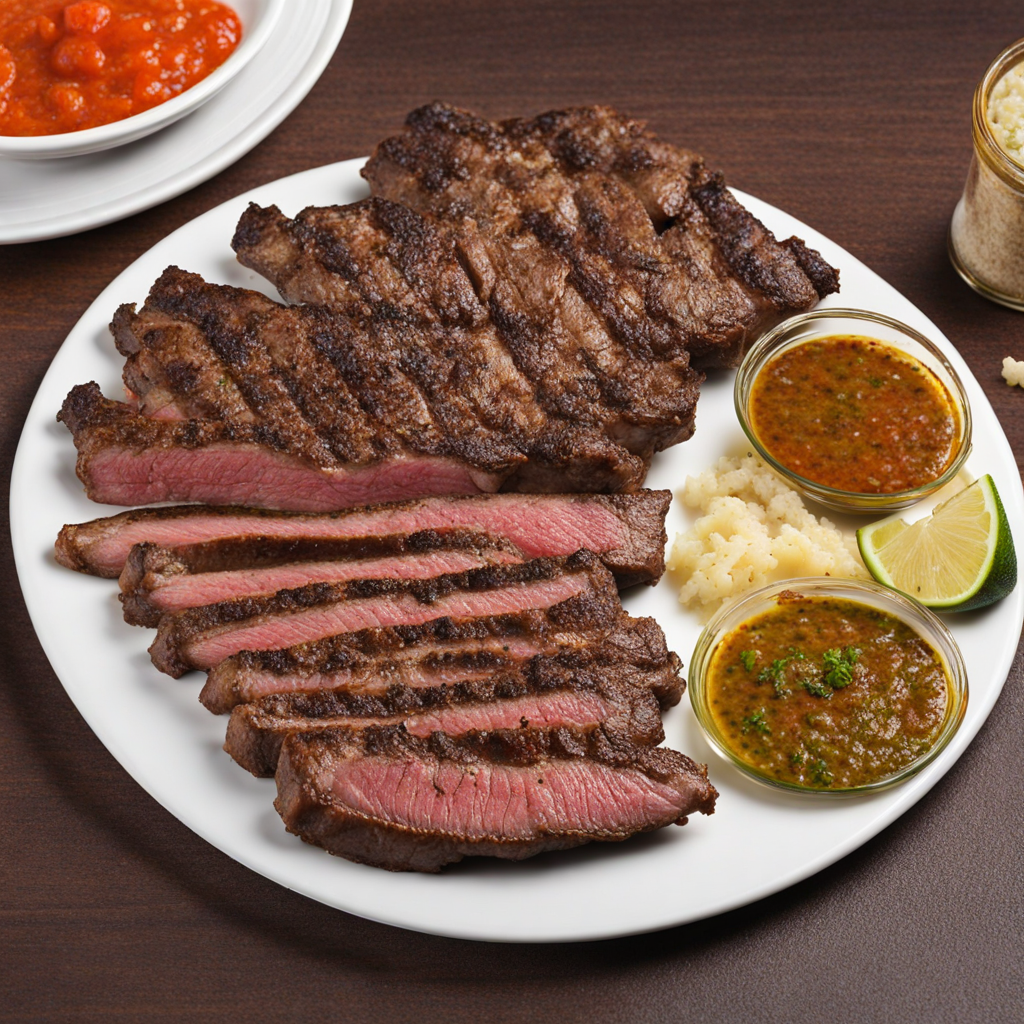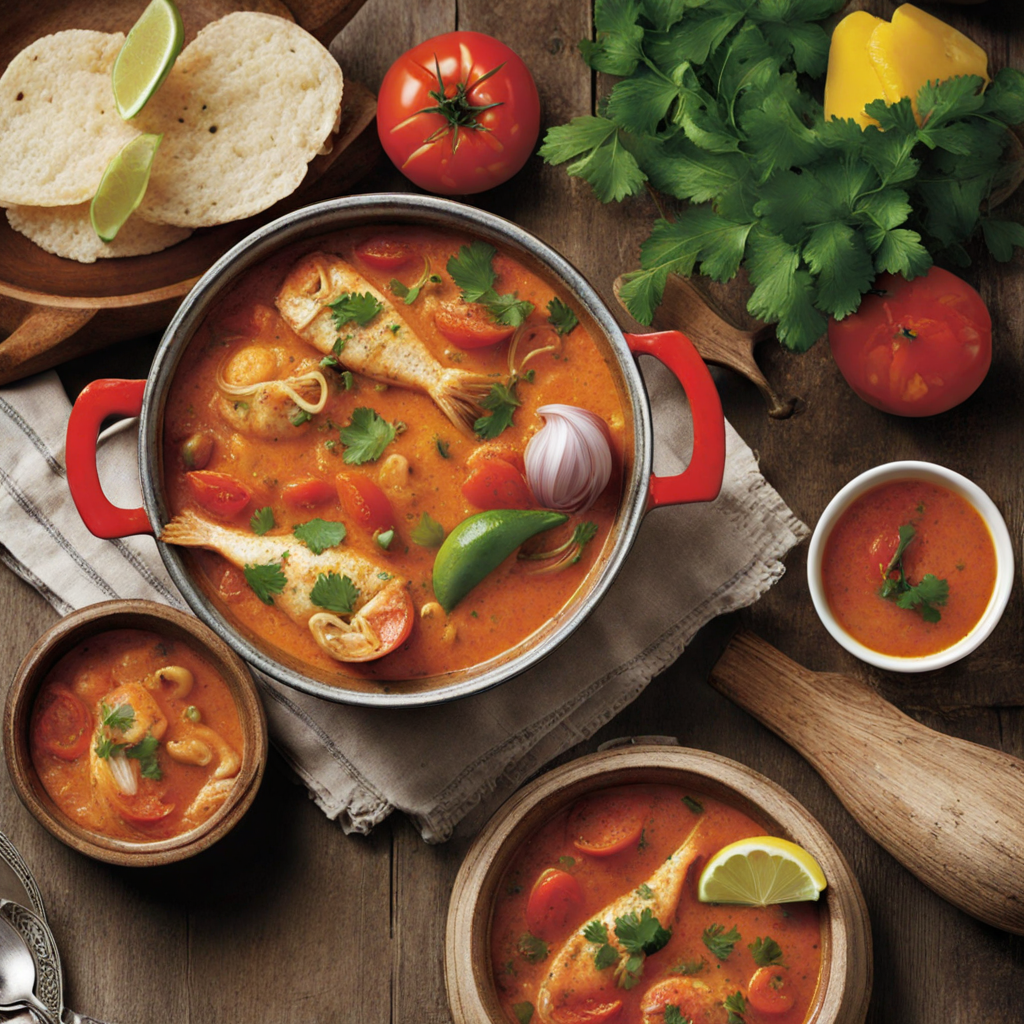Feijão Tropeiro
Feijão Tropeiro is a traditional Brazilian dish that beautifully encapsulates the richness of the country's culinary heritage. Originating from the state of Minas Gerais, it primarily features black beans that are cooked to perfection. The beans are then combined with a medley of ingredients such as crispy bacon, sautéed onions, and garlic, which infuse the dish with a savory depth. The addition of collard greens not only adds a vibrant green color but also a fresh, slightly bitter note that balances the richness of the other components. Every bite is a harmonious blend of textures and flavors, making it a truly satisfying experience. What sets Feijão Tropeiro apart is its unique incorporation of farofa, a toasted cassava flour mixture that adds a delightful crunch and a nutty flavor to the dish. This ingredient not only serves as a thickener but also enhances the overall mouthfeel, creating a contrast to the soft beans and crispy bacon. Often, the farofa is tossed with spices and herbs, elevating the dish with aromatic notes that reflect the diverse flora of Brazil. The dish is often served as a side, accompanying grilled meats or as part of a larger spread during festive occasions, showcasing its versatility. The presentation of Feijão Tropeiro is as inviting as its flavor profile. Typically served in a rustic bowl or on a wooden platter, the dish is garnished with slices of hard-boiled eggs and sometimes a sprinkle of fresh parsley or chives, adding a touch of color and freshness. This dish invites sharing and celebration, making it a staple in Brazilian homes and gatherings. Whether enjoyed at a family meal or during a festive occasion, Feijão Tropeiro promises a delightful journey into the heart of Brazilian cuisine, filled with warmth and comfort.
How It Became This Dish
The Rich History of Feijão Tropeiro: A Culinary Gem of Brazil Feijão Tropeiro is more than just a dish; it is a vibrant tapestry woven into Brazil's cultural and culinary history. This hearty preparation of beans, typically black beans, is enriched with a medley of ingredients such as manioc flour (farinha de mandioca), bacon or sausage, eggs, and various seasonings. Originating in the diverse landscape of Brazil, Feijão Tropeiro embodies the spirit of the nation, reflecting its agricultural roots, regional variations, and the fusion of indigenous and colonial influences. #### Origins and Historical Context The history of Feijão Tropeiro can be traced back to the 17th and 18th centuries during Brazil's colonial period. The dish is believed to have emerged within the context of the tropeiros, the itinerant muleteers who transported goods across Brazil’s vast interior. These travelers, often moving between São Paulo and Minas Gerais, required sustenance that was not only filling but also portable. The combination of beans, which were a staple food among indigenous populations, with ingredients that could withstand the rigors of travel, gave rise to Feijão Tropeiro. The use of black beans is significant; they were cultivated by indigenous peoples long before European colonization. The Portuguese brought with them culinary practices that incorporated meats and spices, creating a fusion that would define Brazilian cuisine. By incorporating bacon, sausage, and eggs into the dish, the tropeiros transformed a simple preparation into a nourishing meal, essential for the long journeys they undertook. #### Cultural Significance Feijão Tropeiro is emblematic of Brazilian identity and cultural heritage. It is not just a dish but a symbol of the blending of cultures: indigenous, African, and Portuguese. Each of these groups contributed to the culinary landscape of Brazil, and Feijão Tropeiro stands as a testament to this rich interaction. In Brazilian cuisine, beans are more than a food source; they hold social significance. They are often associated with communal meals and family gatherings. The preparation of Feijão Tropeiro is especially common in rural areas and during celebrations, where it is served alongside rice, salad, and farofa (toasted manioc flour). The dish is popular in the state of Minas Gerais, known for its rich culinary traditions, and it embodies the warmth and hospitality characteristic of Brazilian culture. The dish is often featured in traditional festivals and gatherings, particularly in the context of the Festa Junina, a celebration that occurs in June, honoring saints and the harvest. Feijão Tropeiro is a staple in these festivities, enjoyed by families and communities as they come together to celebrate. #### Ingredients and Preparation The traditional ingredients of Feijão Tropeiro reflect the agricultural bounty of Brazil. Black beans are simmered until tender, then combined with sautéed bacon or sausage, onions, and garlic. The dish is finished with scrambled eggs and seasoned with salt and pepper. What truly sets Feijão Tropeiro apart, however, is the addition of farinha de mandioca, which gives the dish a unique texture and flavor. This manioc flour is a staple in Brazilian cuisine, derived from the cassava plant, and has been part of the diet since pre-colonial times. The preparation of Feijão Tropeiro can vary greatly from region to region, reflecting local tastes and available ingredients. In some areas, for instance, you might find the addition of greens, while others might incorporate spices and herbs unique to their locality. This adaptability allows Feijão Tropeiro to evolve over time while maintaining its core identity. #### Evolution Over Time As Brazilian society transformed throughout the 19th and 20th centuries, so too did Feijão Tropeiro. The dish began to gain recognition beyond the rural communities, becoming a staple in urban areas as well. The migration of people from the countryside to cities like Belo Horizonte saw traditional recipes adapted to urban lifestyles, making the dish more accessible to a wider audience. By the late 20th century, Feijão Tropeiro became a symbol of national pride. It was featured in restaurants and food festivals, showcasing the richness of Brazilian cuisine to both locals and tourists. Chefs began to experiment with the dish, introducing gourmet versions that highlighted local ingredients, while still respecting its traditional roots. This evolution led to the emergence of several variations, including vegetarian and vegan adaptations that cater to contemporary dietary preferences. The dish’s popularity has also been bolstered by Brazil’s growing interest in gastronomy, where traditional foods are celebrated and reinterpreted. Culinary tours and food festivals often include Feijão Tropeiro, emphasizing its historical significance and cultural roots. #### Conclusion Feijão Tropeiro is more than just a meal; it is a profound reflection of Brazil’s diverse history and rich cultural landscape. From its origins among the tropeiros to its status as a beloved dish celebrated across the nation, Feijão Tropeiro encapsulates the spirit of Brazil itself—an amalgamation of influences, traditions, and flavors. As the world continues to embrace global cuisine, Feijão Tropeiro stands out as a dish that tells the story of resilience, adaptation, and community. It invites us to explore the past while savoring the present, reminding us that food is not just sustenance but a narrative of identity, culture, and history. Whether enjoyed in a rustic diner in Minas Gerais or a modern restaurant in São Paulo, Feijão Tropeiro remains a flavorful connection to Brazil’s rich heritage, a dish that continues to evolve while honoring its roots.
You may like
Discover local flavors from Brazil



